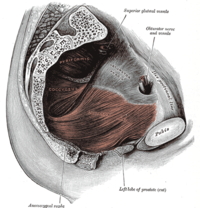
Photo from wikipedia
Transperineal biopsy is becoming more commonly used, driven by improved detection rates, better complication profile and increasing application of prostate MRI leading to guided biopsy. However, it can still lead… Click to show full abstract
Transperineal biopsy is becoming more commonly used, driven by improved detection rates, better complication profile and increasing application of prostate MRI leading to guided biopsy. However, it can still lead to complications such as urinary retention, postoperative pain and erectile dysfunction. There is also a potential for adverse events such as severe infection, abscess and fistula. This article describes a case of an intrascrotal abscess post-transperineal biopsy, which required an orchidectomy.
Journal Title: BMJ Case Reports
Year Published: 2021
Link to full text (if available)
Share on Social Media: Sign Up to like & get
recommendations!